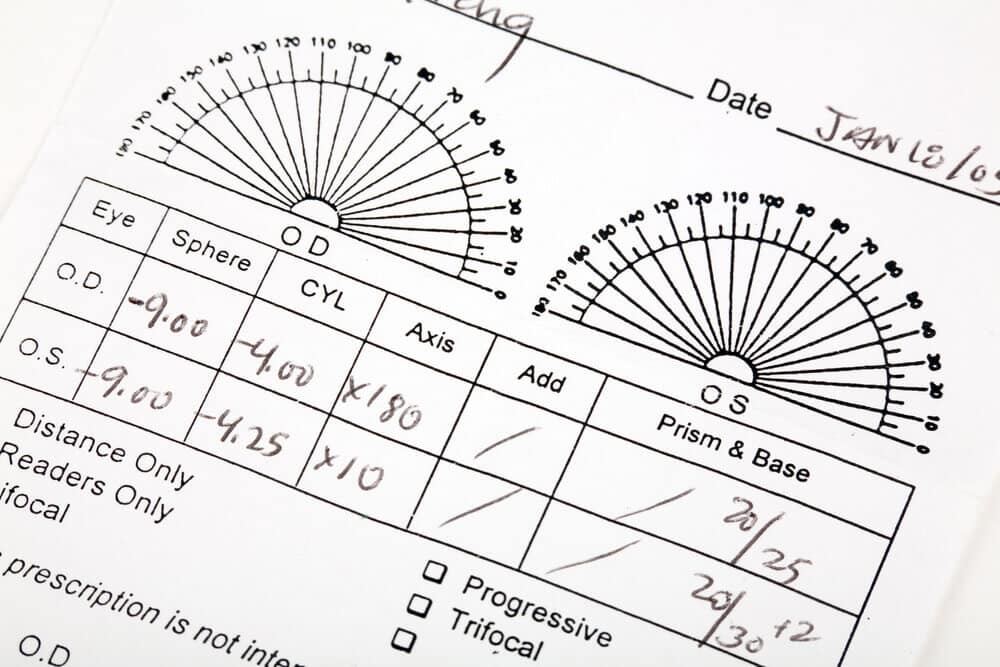After you leave your eye doctor’s office, you’ll likely have a piece of paper with your eyeglass prescription written on it. If you take a look at the script, you’ll see a series of letters and numbers. All of these letters and numbers have a specific meaning, but without knowing how to read your prescription, it can seem pretty confusing. Taking a closer look at your prescription and understanding the value of each letter and number will give you the ability to understand what exactly your prescription means. Let’s dive further into how you can read your prescription.
OD and OS
OD and OS are abbreviations used in eyeglass prescriptions that refer to the patient’s right eye (OD) and left eye (OS), respectively. OD stands for “oculus dexter,” which is Latin for “right eye” while OS stands for “oculus sinister,” which is Latin for “left eye.” Typically, OD is the number that’s written first. This is because the right eye is the eye that’s usually examined first.
Sets of Numbers in Your Eyeglass Prescription

Your prescription typically includes several sets of numbers that describe the type and strength of lenses needed to correct your vision. Here is an explanation of each set of numbers:
- Sphere (SPH): Indicates the amount of nearsightedness (-) or farsightedness (+) in your eyes. It is measured in diopters and may be written with a decimal point (e.g., -2.50 or +1.75).
- Cylinder (CYL): This number indicates the amount of astigmatism in your eyes. Astigmatism is a condition in which the cornea or lens of the eye is curved differently in one direction than in the other, causing distorted or blurred vision. The cylinder number is also measured in diopters and may be written with a decimal point.
- Prism: Indicates the amount of prismatic power needed to correct eye alignment or eye muscle imbalances.
- Base: This number indicates the direction in which the prism is oriented, either up, down, in, or out.
- Add: This number is often used for multifocal lenses, such as bifocals or progressive lenses, and indicates the additional magnifying power needed for reading or other close-up tasks. It is also measured in diopters and may be written with a decimal point.
- Pupillary Distance (PD): The distance between your pupils, measured in millimeters. Your PD is necessary to ensure that the lenses are properly centered in the frames.
It’s important to understand the numbers on your prescription to ensure that you receive the correct lenses for your individual needs.
Astigmatism Axis Number
The axis number in an eyeglass prescription indicates the orientation of the cylinder lens needed to correct astigmatism in your eyes. Astigmatism is a common condition in which the cornea or lens of the eye is curved differently in one direction than in the other, causing distorted or blurred vision.
The axis is measured in degrees, from 0 to 180, and is used to describe the orientation of the cylindrical power in the lens needed to correct astigmatism. The axis number indicates the angle at which the cylindrical power is placed in the lens. For example, an axis of 90 degrees would mean that the cylindrical power is oriented vertically, while an axis of 180 degrees would mean that the cylindrical power is oriented horizontally.
The axis number is an important part of your prescription, as it ensures that the cylindrical power is correctly aligned with your astigmatism. If the axis is incorrect, astigmatism may not be fully corrected, which can result in distorted or blurred vision.
Reading Your Eyeglass Prescription By Yourself

With a better understanding of how to read your prescription, you’ll be able to keep better track of your own medical records. Your eye doctor will help explain to you any differences in your vision and how your prescription is changing over time.
If you have any questions about reading your eyeglass prescription, schedule an appointment with Art of Optiks today.




